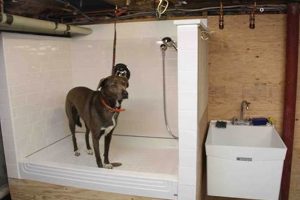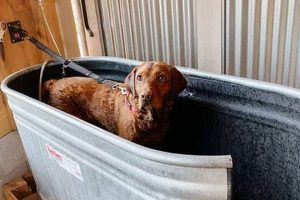Constructing physical barriers to contain canine companions within designated areas is a common requirement for pet owners. These enclosures, frequently built by the owners themselves, take various forms and utilize diverse materials, adapting to specific animal needs, property layouts, and budgetary constraints. Considerations in design often include the dog’s size, breed, temperament, and potential digging or jumping behaviors, alongside the aesthetic preferences of the property owner and adherence to local regulations.
Containing pets safely within a defined space delivers several advantages. It promotes canine well-being by preventing escapes and potential hazards such as traffic or encounters with other animals. It also provides peace of mind for owners, reducing the risk of lost pets and associated anxieties. Furthermore, well-maintained enclosures enhance property value and contribute to a sense of order and security within the neighborhood.
The ensuing discussion will explore different approaches to building secure and affordable canine containment systems, focusing on material selection, construction techniques, and modifications that can enhance both functionality and visual appeal. From repurposed pallets to professionally installed wire mesh, options exist to meet a wide range of needs and skill levels.
Tips for Constructing Canine Containment Barriers
Implementing effective perimeter solutions for dog containment requires careful planning and execution. The following guidelines provide critical insights for ensuring both the security and longevity of the structure.
Tip 1: Assess Canine Behavior: Prior to construction, observe the dog’s typical behavior patterns. Factors such as jumping height, digging propensity, and any existing escape attempts should inform the fence’s overall design and required height.
Tip 2: Material Selection Considerations: Select durable materials appropriate for the environment and the dog’s characteristics. Pressure-treated lumber, heavy-gauge wire mesh, and concrete footings offer increased resistance to weathering and potential damage.
Tip 3: Below-Ground Barrier Implementation: To prevent digging, extend the fence below the surface of the ground. Bury wire mesh or concrete edging at a depth of at least 12 inches, extending outwards from the fence line.
Tip 4: Reinforce Weak Points: Focus on reinforcing corners and gate areas, as these are common points of failure. Use diagonal bracing and heavy-duty hardware to enhance structural integrity.
Tip 5: Consider Visual Obstructions: Dogs may be less inclined to jump if they cannot see beyond the fence. Incorporate solid panels or dense planting to create a visual barrier, reducing the temptation to escape.
Tip 6: Regular Maintenance Schedule: Conduct routine inspections to identify and address any damage promptly. Repairing loose boards, tightening hardware, and treating wood will prolong the fence’s lifespan.
Tip 7: Adhere to Local Regulations: Before commencing construction, verify compliance with all applicable zoning ordinances and homeowner association guidelines related to fence height, materials, and setback requirements.
These guidelines, if carefully implemented, significantly enhance the security and effectiveness of perimeter solutions for pet containment. Such measures offer increased safety for the animal and minimize potential liability for the property owner.
The next section of this article will delve into specific construction methodologies.
1. Material Durability
The selection of robust materials is paramount when undertaking canine containment construction. The longevity and effectiveness of these barriers are directly contingent upon the capacity to resist environmental degradation and withstand animal-induced stress. Failure to prioritize material durability can result in premature structural failure, necessitating costly repairs and compromising canine security.
- Weather Resistance
Exterior structures are continuously subjected to weathering processes, including precipitation, temperature fluctuations, and ultraviolet radiation. Untreated wood, for example, is susceptible to rot and decay, while certain metals can corrode. Utilizing pressure-treated lumber, galvanized steel, or weather-resistant composites minimizes these effects, extending the lifespan of the enclosure. Consider that a wooden fence in a humid climate will degrade more rapidly than one in an arid environment, highlighting the importance of climate-appropriate material choices.
- Impact Resistance
Dogs, particularly larger breeds, may exert considerable force against fences, either intentionally or unintentionally. Materials with low impact resistance, such as thin vinyl or brittle plastics, are prone to cracking or shattering under pressure. Selecting materials with high tensile strength and impact resilience, such as heavy-gauge wire mesh or reinforced composite panels, ensures the structure can withstand potential stress from canine activity. Imagine a large dog repeatedly jumping against a vinyl fence; the likelihood of failure is significantly higher than with a chain-link fence.
- Resistance to Digging and Chewing
Certain dogs exhibit a propensity for digging or chewing, which can compromise the integrity of perimeter barriers. Wooden posts and panels are vulnerable to chewing, while weaker materials can be easily excavated. Implementing measures such as burying wire mesh at the base of the fence or employing concrete footings mitigates digging. Choosing materials that are less appealing or more resistant to chewing, like metal or treated lumber, reduces the likelihood of damage. A determined dog can quickly dismantle a poorly constructed or inappropriately-materialed fence.
- Structural Integrity Over Time
The capacity of materials to maintain their structural integrity over extended periods is a critical consideration. Materials prone to warping, sagging, or settling can compromise the overall stability and security of the fence. Utilizing materials with inherent dimensional stability and proper installation techniques ensures the enclosure remains functional and aesthetically pleasing for years to come. A fence constructed with improperly seasoned lumber may warp and lean over time, creating gaps and weakening the structure.
Consequently, a comprehensive evaluation of material properties is essential when planning canine containment structures. Careful consideration of weathering resistance, impact resistance, digging/chewing prevention, and long-term structural integrity maximizes the lifespan and effectiveness of the DIY endeavor. The investment in durable materials translates directly to reduced maintenance costs and enhanced canine security.
2. Height Adequacy
Height adequacy constitutes a critical design parameter in canine containment structures. The vertical dimension of a fence directly influences its capacity to deter escape attempts by leaping. Insufficient height renders a perimeter barrier ineffective, compromising the safety of the animal and potentially leading to property damage or liability concerns. Effective implementations must consider canine jumping capabilities.
- Breed-Specific Considerations
Different canine breeds exhibit varying jumping propensities. Smaller breeds, such as Dachshunds, typically require lower barriers than larger, more athletic breeds like Greyhounds or Border Collies. Researching the typical jumping height of a specific breed is essential for establishing minimum fence height requirements. A fence that effectively contains a small terrier may prove wholly inadequate for a larger, more agile breed.
- Age and Physical Condition
The age and physical condition of the dog influence its jumping ability. Younger, more athletic dogs are generally capable of jumping higher than older or less active animals. Similarly, dogs with joint problems or other physical limitations may have reduced jumping capacity. The fence height should be appropriate for the dog’s current physical condition and should anticipate potential increases in jumping ability as the dog matures. An older dog might be less of an escape risk than a young, energetic puppy.
- Environmental Factors
The surrounding environment can impact perceived fence height. Objects near the fence, such as trees, shrubs, or stacked materials, may provide a jumping platform, effectively reducing the barrier’s perceived height. Additionally, sloping terrain may create localized areas where the fence is lower than intended. Careful site assessment is crucial to identify and mitigate potential jumping aids. A strategically placed tree adjacent to a fence can significantly reduce its effectiveness as a barrier.
- Psychological Deterrents
While physical height is essential, psychological deterrents can enhance the effectiveness of a canine containment structure. Visual barriers, such as solid panels or closely spaced pickets, can discourage jumping by preventing the dog from seeing beyond the fence. Similarly, features like overhanging extensions or electric wiring (when used responsibly and in compliance with local regulations) can create an aversion to jumping. A solid fence, even if not excessively tall, may be more effective than a taller, see-through fence for certain dogs.
Therefore, appropriate fence height requires a multifaceted approach, encompassing breed-specific jumping abilities, age and physical condition, environmental considerations, and psychological deterrents. Integrating these factors into the planning and implementation phase of a self-constructed canine enclosure enhances its efficacy and promotes both animal safety and responsible pet ownership. Careful consideration mitigates the need for costly modifications or complete fence replacements down the line, supporting the goals of “diy fence ideas for dogs”.
3. Dig Prevention
Dig prevention forms an integral component in the successful implementation of canine containment structures. A dog’s natural instinct to dig can compromise the integrity of a fence, creating escape routes and rendering the barrier ineffective. Integrating proactive dig prevention measures into the design and construction phases of a DIY fence is essential for long-term security and functionality.
- Buried Barrier Extension
Extending the fence material below ground level provides a physical impediment to digging. This approach typically involves burying wire mesh, chain-link fencing, or solid materials like concrete at a depth of at least 12 inches. The buried section should also extend outwards from the fence line to discourage digging directly adjacent to the barrier. Example: burying hardware cloth 18 inches deep, extending 6 inches outward, has proven effective in deterring persistent diggers. This method directly addresses the issue, creating a secure perimeter.
- Concrete Footer Installation
A concrete footer, installed beneath the fence line, represents a more robust solution for dig prevention. The footer acts as a solid, impenetrable barrier, preventing excavation beneath the fence. This method is particularly effective in areas with sandy or loose soil conditions. Example: a 6-inch deep, 12-inch wide concrete footer provides substantial resistance against digging, especially when combined with securely anchored fence posts. This creates a robust defense line, preventing animals from undermining the containment system.
- L-Footers and Angle Iron
Employing L-footers, which are sections of wire mesh or metal bent at a 90-degree angle, offers an alternative to full burial. The horizontal section of the L-footer extends outwards from the base of the fence, discouraging digging. Angle iron can also be used to achieve a similar effect. Example: Using 1/4″ thick angle iron bent at 90 degrees and bolting it to the bottom of the fence can prevent dogs from attempting to dig under. The outward-facing segment prevents successful excavation directly at the fence line.
- Gravel or Rock Base
Creating a gravel or rock base along the fence line can deter digging. The uneven surface and discomfort associated with digging in this material can dissuade dogs from attempting to excavate. Example: A 6-inch deep layer of crushed gravel, extending 12 inches from the fence line, can effectively deter digging in many cases. While not foolproof, it can be a simple and aesthetically pleasing addition to a canine containment system.
The effective application of dig prevention techniques depends on factors such as the dog’s breed, digging habits, and soil conditions. Employing a combination of these strategies may be necessary to achieve optimal results. Successfully integrating these dig prevention methodologies into the “diy fence ideas for dogs” significantly enhances the security and longevity of the containment system, ultimately contributing to the well-being of the animal and responsible pet ownership.
4. Gate Security
Gate security represents a critical vulnerability point within any canine containment system. Even a meticulously constructed fence perimeter becomes ineffective if the gate provides an avenue for escape. Consequently, the design, installation, and maintenance of the gate hardware must receive deliberate attention during the planning and execution phases of a DIY fence project. Compromised gate security invalidates the effort invested in the surrounding fence structure.
One primary cause of gate failure is inadequate latch mechanisms. Simple hook-and-eye latches are often insufficient, particularly for larger or more determined breeds. More robust options include self-latching mechanisms, gravity latches, or even double-latching systems that require deliberate action to disengage. The latch must be positioned beyond the dog’s reach and be resistant to manipulation. A real-life example is a Rottweiler escaping a yard simply by nudging a flimsy latch open. Such instances underscore the necessity of heavy-duty, strategically positioned gate hardware. Another critical consideration is the structural integrity of the gate posts. If the posts are not securely anchored, the gate can sag, misalign, and become difficult to latch, creating a potential escape point. Properly sized and set posts, ideally anchored in concrete footings, are essential. The gate itself should be constructed from materials consistent with the overall fence, ensuring comparable strength and durability. Regular inspection and maintenance of the gate hardware are also crucial. Hinges should be lubricated to prevent binding, and latches should be adjusted to ensure proper engagement. Failing to address these small issues can lead to a complete gate failure, negating all previous containment efforts.
Ultimately, gate security, within the context of DIY canine containment systems, demands a holistic approach, encompassing robust hardware, structurally sound support, and diligent maintenance. Neglecting any of these aspects significantly increases the risk of canine escape and undermines the effectiveness of the overall enclosure. Prioritizing gate security transforms the DIY fence from a mere structure into a genuine and reliable canine containment solution.
5. Aesthetic Integration
The successful implementation of canine containment often transcends purely functional considerations, extending to the visual harmony between the enclosure and its surrounding environment. “Aesthetic Integration,” in the context of “diy fence ideas for dogs,” describes the deliberate effort to design and construct a barrier that complements the existing landscape, architectural style, and overall property aesthetics. Neglecting this element can result in a visually jarring or unattractive structure, detracting from property value and diminishing the enjoyment of outdoor spaces. The appearance of the enclosure becomes as crucial as its function, as most dog owners do not want an eyesore in their yard.
Achieving visual coherence necessitates careful material selection, color choices, and design details. For instance, a rustic split-rail fence might seamlessly blend with a wooded property, while a sleek, modern metal fence could better complement a contemporary home. The use of natural materials, such as wood or stone, can create a more organic and integrated appearance. Incorporating landscaping elements, such as climbing vines or strategically placed shrubs, can further soften the visual impact of the fence and create a more visually appealing barrier. Consider a scenario where a homeowner constructs a basic chain-link fence around a meticulously landscaped garden. While functional, the stark contrast between the utilitarian fence and the lush garden diminishes the overall aesthetic appeal. Conversely, a carefully stained wooden fence, adorned with climbing roses, would enhance the garden’s beauty while still providing effective canine containment.
In conclusion, aesthetic integration represents a significant aspect of responsible pet ownership and property management. By prioritizing visual harmony in the design and construction of canine containment structures, property owners can create functional and attractive enclosures that enhance the overall aesthetic appeal of their properties. Balancing the practical needs of pet containment with the desire for visual coherence elevates the DIY fence project beyond a mere construction task, transforming it into an opportunity for creative expression and property enhancement. Therefore, successful implementation of “diy fence ideas for dogs” balances aesthetic concerns with safety and security.
Frequently Asked Questions
This section addresses common inquiries regarding the planning, construction, and maintenance of self-built canine containment systems. These questions and answers are designed to provide clear, concise information to property owners seeking to create secure and aesthetically pleasing enclosures for their pets.
Question 1: What is the minimum recommended height for a canine containment fence?
The minimum recommended height varies depending on the dog’s breed, size, and jumping ability. As a general guideline, a fence height of four feet is suitable for smaller breeds, while larger, more athletic breeds may require a fence height of five to six feet or higher. Observation of the dog’s jumping behavior is crucial in determining the appropriate height.
Question 2: How can digging beneath a fence be effectively prevented?
Digging can be prevented by extending the fence material below ground level. Burying wire mesh, chain-link fencing, or a concrete footer at a depth of at least 12 inches is recommended. Additionally, an outward extension of the buried material can further deter digging directly adjacent to the fence line.
Question 3: What are the key considerations for selecting appropriate fencing materials?
Material selection should prioritize durability, weather resistance, and resistance to chewing or digging. Pressure-treated lumber, galvanized steel, heavy-gauge wire mesh, and composite materials are all viable options. The choice should reflect the local climate, the dog’s behavior, and the desired aesthetic.
Question 4: How can gate security be maximized in a canine containment system?
Gate security can be enhanced by using self-latching mechanisms, gravity latches, or double-latching systems. The latch should be positioned beyond the dog’s reach and be resistant to manipulation. Additionally, the gate posts should be securely anchored, preferably in concrete footings, to prevent sagging or misalignment.
Question 5: Is it necessary to obtain permits before constructing a canine containment fence?
Permit requirements vary depending on local zoning regulations and homeowner association guidelines. Before commencing construction, it is essential to verify compliance with all applicable rules and regulations. Failure to obtain necessary permits can result in fines or the requirement to remove the fence.
Question 6: How often should a canine containment fence be inspected and maintained?
Regular inspection and maintenance are crucial for ensuring the long-term effectiveness of the fence. Inspections should be conducted at least quarterly to identify any damage, loose hardware, or areas requiring repair. Timely maintenance can prevent minor issues from escalating into significant problems.
These answers address frequently encountered questions. Implementation of these methodologies enhances canine safety and promotes owner peace of mind.
The subsequent section provides a list of resources to facilitate canine containment building.
Conclusion
This discussion has elucidated various facets of creating self-constructed enclosures. Key considerations encompass canine behavior analysis, material selection based on environmental and animal factors, implementation of below-ground barriers, structural reinforcement, and adherence to local regulations. Attention to these details directly affects the containment system’s longevity and effectiveness.
The diligent application of information provided herein fosters secure and visually integrated pet enclosures. The success of “diy fence ideas for dogs” rests on prioritizing canine well-being and responsible pet ownership, thereby contributing to community safety and harmonious co-existence. Continued vigilance regarding maintenance and adaptation to evolving pet needs will ensure sustained functionality.







